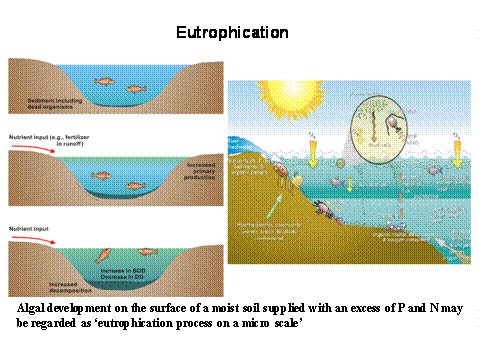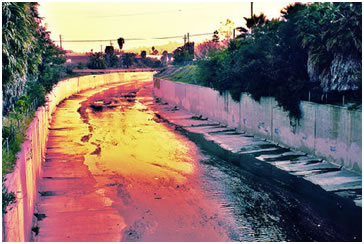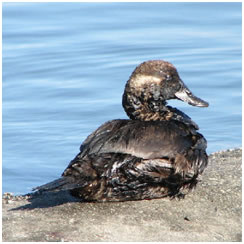Environment & Pollution :: Water Pollution
Water pollution
Overview
Water pollution is contamination of water by foreign matter that deteriorates the quality of the water. Water pollution covers pollutions in liquid forms like ocean pollution and river pollution. As the term applies, liquid pollution occurs in the oceans, lakes, streams, rivers, underground water and bays, in short liquid-containing areas. It involves the release of toxic substances, pathogenic germs, substances that require much oxygen to decompose, easy-soluble substances, radioactivity, etc. that becomes deposited upon the bottom and their accumulations will interfere with the condition of aquatic ecosystems. For example, the eutrophication: lack of oxygen in a water body caused by excessive algae growths because of enrichment of pollutants.
Impact of fertilizer phosphorus on the environment
Excess P Detrimental effect
Eutrophication
- Depleting of dissolved oxygen produces conditions that facilitate chemical transformation into toxic forms
- Increasing cost and difficulty in purifying drinking water
- Changing local ecosystem
- Increasing sedimentation and impairs recreational water use
- Producing surface scums and odors
- Increasing insect populations

Ways to reduce Eutrophication
- Catchment management options
- Use optimum dose of P fertilizers
- Type of P fertilizers
- Use organic manures
- Modify drainage system
Chemical treatment
Water Cycle and Pollution
Water cycle is, simply saying, the circulation of water in earth. In fact, the water in the earth's biosphere is used and reused again and again. This is called water cycle or continuous movement of water between the earth and the atmosphere. It involves the following mechanisms:
- Evaporation: changing of water from liquid to gas
- Transpiration: Release of water vapor from plant leaves
- Condensation: changing of vapor to liquid (cooled down)
- Precipitation: Water that returns to the earth (water droplets in clouds become large enough and there comes the rain).
Relation of water cycle and pollution
According to the water cycle, naturally, water around us will be absorbed to the land (soil) and rivers will stream from the upstream to the downstream and released to the sea. In normal situation organic pollutants are biodegraded by microbes and converted to a form that brings benefits to the aquatic life. And for the inorganic pollutants, in the same situation, don't bring to much hazards because they are widely dispersed and have almost no effect to the environment which they are released to.
In a small scale, both inorganic and organic pollutants safely decompose throughout the stream, their concentration decrease in the sea, and they don't harm the sea ecosystem and its distribution. But in an excessive scale, communities in beach and estuary will be affected by the pollutants, and can heavily harm them.
Sources and Methods
We can classify major sources that lead to water pollution to the following categories:
- petroleum products
- synthetic agricultural chemicals
- heavy metals
- hazardous wastes
- excess organic matter
- sediment
- infectious organisms
- air pollution
- thermal pollution
- soil pollution
Water Pollution Effects on humans
Waterborne diseases caused by polluted drinking water:
- Typhoid
- Amoebiasis
- Giardiasis
- Ascariasis
- Hookworm
Waterborne diseases caused by polluted beach water:
- Rashes, ear ache, pink eye
- Respiratory infections
- Hepatitis, encephalitis, gastroenteritis, diarrhoea, vomiting, and stomach aches
Conditions related to water polluted by chemicals (such as pesticides, hydrocarbons, persistent organic pollutants, heavy metals etc):

Water Pollution effects
- Cancer, incl. prostate cancer and non-Hodgkin’s lymphoma
- Hormonal problems that can disrupt reproductive and developmental processes
- Damage to the nervous system
- Liver and kidney damage
- Damage to the DNA
- Exposure to mercury (heavy metal):
- In the womb: may cause neurological problems including slower reflexes, learning deficits, delayed or incomplete mental development, autism and brain damage
- In adults: Parkinson’s disease, multiple sclerosis, Alzheimer’s disease, heart disease, and even death
Other notes:
- Water pollution may also result from interactions between water and contaminated soil, as well as from deposition of air contaminants (such as acid rain)
- Damage to people may be caused by fish foods coming from polluted water (a well known example is high mercury levels in fish)
- Damage to people may be caused by vegetable crops grown / washed with polluted water (author’s own conclusion)
Effects of Water Pollution on Animals
- Nutrient pollution (nitrogen, phosphates etc) causes overgrowth of toxic algae eaten by other aquatic animals, and may cause death; nutrient pollution can also cause outbreaks of fish diseases

Oil Coated Duck
- Chemical contamination can cause declines in frog biodiversity and tadpole mass
- Oil pollution (as part of chemical contamination) can negatively affect development of marine organisms, increase susceptibility to disease and affect reproductive processes; can also cause gastrointestinal irritation, liver and kidney damage, and damage to the nervous system
- Mercury in water can cause abnormal behavior, slower growth and development, reduced reproduction, and death
- Persistent organic pollutants (POPs) may cause declines, deformities and death of fish life
- Too much sodium chloride (ordinary salt) in water may kill animals (7)
Other notes:
- We also assume that some higher forms of non-aquatic animals may have similar effects from water pollution as those experienced by humans, as described above.
Effect of Water Pollution on trees and plants
- May disrupt photosynthesis in aquatic plants and thus affecting ecosystems that depend on these plants
- Terrestrial and aquatic plants may absorb pollutants from water (as their main nutrient source) and pass them up the food chain to consumer animals and humans
- Plants may be killed by too much sodium chloride (ordinary slat) in water
- Plants may be killed by mud from construction sites as well as bits of wood and leaves, clay and other similar materials
- Plants may be killed by herbicides in water; herbicides are chemicals which are most harmful to plants
Water Pollution Management
Bioremediation
- Enhance the development of indigenous microorganisms to accelerate biodegradation of organic constituents in saturated zone
- Effective for full range petroleum hydrocarbon (except MTBE, long chain, high molecular weight and insoluble constituents)
- Accepted in combination with other saturated zone remedial technology (e.g. air sparging) and vadose zone remedial operations (e.g. soil vapor extraction, bioventing)
- Mechanism criterion: electron acceptor (oxygen, nitrate), nutrients (nitrogen, phosphorus), energy source (carbon)
- Treatment modes: aerobic (oxygen respiration), anoxic (nitrate respiration), anaerobic (non-oxygen respiration), co-metabolic
|
Dual-Phase Extraction
- Elimination of every types of contaminants of groundwater, separate-phase of petroleum products, hydrocarbon vapor from subsurface, which are treated and collected for disposal or re-injected to the subsurface
- Effective in removal of separate phase products from subsurface, due to great efficiency of extraction rates which increase biodegradation of petroleum constituents by increasing supply of oxygen, similar to bioventing
- Mechanism criterion: vacuum, hydraulics and water
- Treatment modes
- Subsurface liquid(s) and soil vapor are extracted as a high velocity dual phase stream using a single pump
- Subsurface liquid(s) and soil vapor are extracted separately using 2 or more pumps
Natural Attenuation
- Passive remedial approach that depends upon natural processes to degrade and dissipate petroleum constituents
- Reduce potential impact of emission of petroleum products by neutralizing the harmful effects or by preventing constituents from being transported to sensitive receptors
- Suitable for sites under active remediation which can significantly decrease level of contaminants
- Mechanisms:
- Destructive (biological processes): aerobic (oxygen respiration), anaerobic (non-oxygen respiration), hypoxic (low oxygen content)
- Non-destructive (physical phenomena): volatilization, dispersion (mechanical mixing and molecular diffusion) and absorption
Biological Agents
- Chemicals or organisms that hasten the rate at which natural biodegradation occurs
- Rapid removal of spilled oil from shorelines and wetlands is necessary in order to minimize potential environmental damage to these sensitive habitats
- Mechanism criterion: aerobic or anaerobic microorganisms which are decomposers (e.g. bacteria).
- Treatment modes:
- Fertilization: Nutrient enrichment by addition of phosphorus and nitrogen to a contaminated environment to accelerate the growth of microorganisms for biodegradation
- Seeding: Introduction of microorganisms to existing native soil.
Dispersing Agents
- Chemicals that contain surfactants which catabolyze oil into small droplets which disperse into the water column where they are subjected to natural processes from wind, waves and currents that further accelerate breakdown
- Effectiveness of dispersants are influenced by water salinity, temperature and conditions at sea
- Frequently used at rough or choppy conditions at sea where mechanical containment and cleanup difficult
Sorbents
- Materials that soak up liquid, which is oleophillic (oil attracting) and hydrophobic (water repellent)
- Effective in oil spills, depend on:
- Rate of absorption determined by type of sorbents and the type of oil
- Oil retent determined by viscosity of liquid
- Ease of application determined by type of sorbents and the type of oil
- materials or sorbents:
- Natural organic: loose particles such as sawdust which can soak up 3 and 15 times their weight of oil with the help of a flotation device to overcome the sinking problem
- Natural inorganic: clay, perlite, vermiculite, glass wool, sand or volcanic ash which can absorb 4 to 20 times their weight in oil
- Synthetic: polyurethane, polyethylene, nylon fibres which can absorb 70 times their weight in oil where some can be cleaned and reuse while some had to be disposed after first use.
|
|

